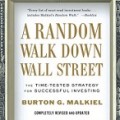I thought I would take a moment to compare and contrast two of the greatest investing books of our time – The Intelligent Investor and A Random Walk Down Wall Street.
The Intelligent Investor, written by Benjamin Graham in 1949, is a book that has stood the test of time and remains a must-read for any serious investor. Graham’s approach to investing is based on the principles of value investing, which involves seeking out stocks that are undervalued by the market and buying them with the expectation that their value will eventually be recognized by the market.
One of the key ideas in The Intelligent Investor is the concept of “Mr. Market,” a hypothetical person who represents the mood swings of the stock market. Graham advises investors to approach Mr. Market with a healthy skepticism, as he can be irrational and emotional at times. Instead of being swayed by Mr. Market’s mood swings, Graham advises investors to focus on a company’s fundamental data, such as its financial statements and management team, when deciding whether to buy or sell a stock.
Another important aspect of Graham’s approach is the idea of margin of safety, which involves buying stocks at a price that is significantly lower than their intrinsic value. This is meant to provide a buffer against potential declines in the stock market, as well as allow for the possibility of above-average returns if the stock’s value eventually rises.
A Random Walk Down Wall Street, written by Burton Malkiel in 1973, presents a different perspective on investing. Malkiel’s book is based on the idea of efficient markets, which suggests that it is impossible to consistently outperform the market because stock prices reflect all available information. According to Malkiel, the best way for investors to achieve good returns is to diversify their portfolio and hold a mix of stocks, bonds, and other assets.
One of the key arguments in A Random Walk Down Wall Street is that individual investors are at a disadvantage when it comes to outperforming the market. Malkiel argues that the vast amount of information available to professional investors, as well as their access to advanced tools and technology, makes it difficult for individual investors to keep up. Instead of trying to outsmart the market, Malkiel advises individual investors to simply hold a diversified portfolio and let the market work its magic.
There are some key differences between The Intelligent Investor and A Random Walk Down Wall Street. One of the main differences is their approach to risk management. Graham’s The Intelligent Investor advocates for a more active approach to risk management, through the use of analysis and diversification. In contrast, Malkiel’s A Random Walk Down Wall Street takes a more passive approach, suggesting that investors should simply hold a diversified portfolio and not try to outsmart the market.
Another difference between the two books is their view on the role of the investor. Graham’s The Intelligent Investor presents the investor as a disciplined and thoughtful individual who is capable of making informed decisions about which stocks to buy and sell. In contrast, Malkiel’s A Random Walk Down Wall Street suggests that the individual investor is at a disadvantage when it comes to outperforming the market, and that it is better to simply hold a diversified portfolio and let the market work its magic.
Ultimately, both The Intelligent Investor and A Random Walk Down Wall Street are valuable resources for investors. While they have some differences in their approach to risk management and the role of the investor, both books offer valuable insights and guidance for anyone looking to invest in the stock market. Whether you prefer Graham’s value investing approach or Malkiel’s efficient market perspective, there is something to be learned from both of these classics.










Leave a Reply